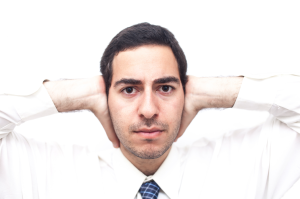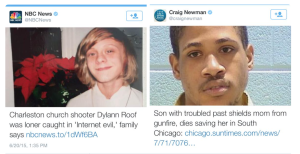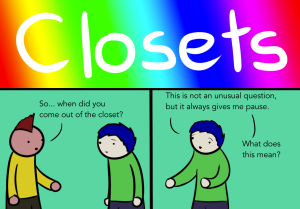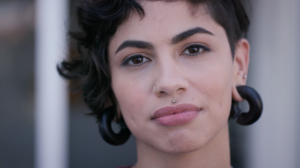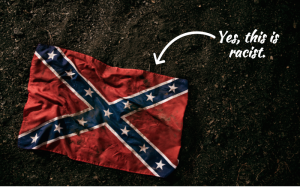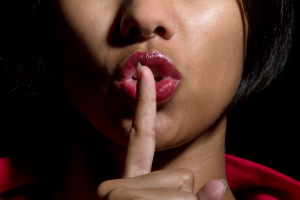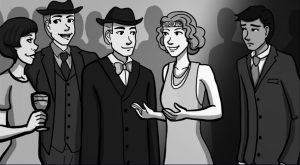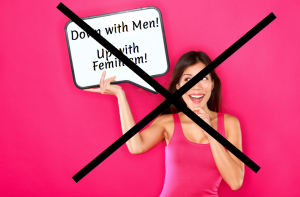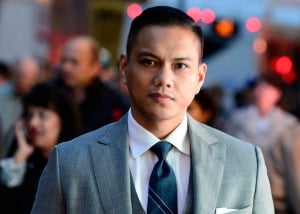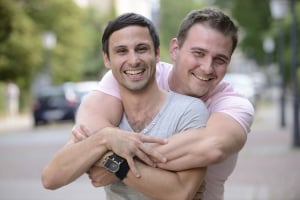
Two people standing outside embracing and smiling widely at the camera. Source: Cardone Reproductive Medicine
Used to describe something that’s been around much longer than the word itself, the phenomenon of homonormativity is considered by many to be destructive to the queer rights movement and to the larger queer community.
Homonormativity is a word that addresses the problems of privilege we see in the queer community today as they intersect with White privilege, capitalism, sexism, transmisogyny, and cissexism, all of which end up leaving many people out of the movement toward greater sexual freedom and equality.
So what does it mean, and more importantly, how does it manifest in our everyday lives?
First, let’s examine it’s counterpart, heteronormativity. This is a word that similarly describes the evaluation of “normal” sexuality that we see in our culture, from the policy and institutional level down to the interpersonal.
Much is being written about heteronormativity, which describes the assumption and promotion that heterosexuality is the only “normal” and “natural” orientation out there, privileging those who fit the norm and positing anyone outside of this as abnormal and wrong.
Our culture is deeply heteronormative, but as queer experiences and rights become more accepted, a policing of sexual and gender expressions within LGBQ spaces is also growing. This is homonormativity.
Homonormativity explains how certain aspects of the queer community can perpetuate assumptions, values, and behaviors that hurt and marginalize many folks within this community, as well as those with whom the community should be working in solidarity.
It addresses assimilation, as well as intersection of corporate interests and consumerism within LGBQ spaces.
It also describes the assumption that queer people want to be a part of the dominant, mainstream, heterosexual culture, and the way in which our society rewards those who do so, identifying them as most worthy and deserving of visibility and rights.
We see homonormativity every day, but it can be so entrenched in queer culture that we don’t really recognize it as problematic.
So how does homonormativity manifest structurally in our culture today?
Who Is Visible?
As social attitudes change around queer relationships, we’re seeing more representations of queer people in the media, though this representation is incredibly limited.
Turn on the TV or flip through a magazine – for each of the few times that you’ll see a queer person, they’ll more than likely be a cisgender, gender-normative, White, middle class, gay-identifying person.
From the television shows Modern Family and The New Normal to TV personalities Anderson Cooper and Neil Patrick Harris, the voices that are given space and visibility tend to be those of a particular class, of a particular gender expression, and of a particular race.
The kinds of queer relationships we see represented in the media are also limiting, in that they tend to mimic heteronormative binary gender expressions.
This is not to say that things aren’t changing – we’re gradually seeing more transgender people and people of Color being represented, but even then, their representation is limited, and often based on stereotypes.
The stereotypes and tropes of LGBQ people in media do more than simplify and minimize the complex realities of queer people; they participate in setting up a standard of a normative way to “be” LGBQ.
This standard privileges certain experiences — those of White, middle-class, gay, cisgender and gender normative identities — as being representative of all queer experiences.
This “whitewashing” goes beyond just what we see in the media around queer lives. It’s also seen in the representation of the queer rights movement, historically and today, as being largely driven by White, masculine, cisgender men.
This erasure of transgender people, cisgender women, and people of Color is not only historically inaccurate, it positions White men as the main historical and current agents of change.
Marriage Equality as the Major Goal of the Gay Rights Movement™
As we’ve seen the issue of marriage equality gain success, swooping the nation in election after election, we have to question its position as The Gay Rights Issue™.
Fighting for sexual liberation and equality is, of course, so much more than fighting for the right to marry, but how is the positioning of marriage equality as the major issue also promoting homonormativity?
Marriage as an issue sets up the requirement that all relationships should mimic this heteronormative standard of sexuality and family structure. It promotes the idea that all people want to emulate straight monogamous couples.
When we focus only on this issue, we exclude polyamorous and other non-normative relationship structures as acceptable, as well as, of course, those who don’t want to get married.
Even as marriage becomes inclusive of a particular kind of queer relationship, it perpetuates a policing of other kinds of relationships, maintaining the borderline of what is an “acceptable queer relationship.”
The focus on marriage challenges very little, prioritizing the legal sanctioning of one’s relationships over real relational and societal transformation.
By showing that people outside of the heterosexual norm want the same things that “traditional, straight America” wants, the marriage equality movement fights to gain access to this social institution by reproducing, rather than challenging, heterosexual dominance and normativity and using this as a basis for who deserves rights.
The Human Rights Campaign (And Other Major Non-Profits)
As one of the largest and most influential LGBT organizations in the country, the Human Rights Campaign (HRC) is a major symbol of homonormativity, and many activists have and continue to challenge its role in the movement.
Here are just a handful of examples why the HRC is not representative of, nor is it an answer to, the queer rights movement:
The HRC continues to exclude and further marginalize the lives of trans and gender non-confirming people.
Most notably, in 2007, the HRC chose to support a non-inclusive version of the federal Employment Non-Discrimination Act, that excluded protections based on gender identity, while most other LGBTQIA+ lobbying groups chose to support the inclusive version.
The HRC supports corporations and banks that are harmful to queer communities, most notably its decision to honor Goldman Sachs with its Workplace Equality Innovation Award in 2011, an organization that symbolizes corporate greed and perpetuates economic inequality.
What does it say when a “queer rights” organization honors a corrupt and destructive company like Goldman Sachs while ignoring issues caused by economic inequality, such as queer youth homelessness?
The HRC has and continues to ignore racism as an issue that intersects with queer rights, not even listing race as a “topic” on their website.
They have also been silent about issues relating to the prison system and police violence (which should matter to them because queer people are disproportionately criminalized and incarcerated).
This shows a lack of intersectional understanding in the organization, that the organization is led by and privileges White middle-class experiences, and that it does not actually intend to challenge systemic, structural oppression.
These problems are not limited to the HRC, but are reflective of the larger non-profit industrial complex that tends to require that more energy go into funding, building relationships with those in power, and working from a top-down approach, than it does building an actual movement for change.
We see this value-system reproduced in many other activist organizations.
Organizations such as the HRC — which prioritize money, power, and reforms benefitting those who are already privileged within the movement — must be challenged.
They should not be speaking for or profiting from our movement, and they will not lead us to real and inclusive liberation and equality.
The Silence Around Chelsea Manning
The mainstream queer rights movement has been largely silent around the issue of Chelsea Manning, a military whistle-blower who exposed classified information about the US’s unjust detainment and torture of people in Guantanamo Bay, the civilian casualties of the wars in Iraq and Afghanistan, the role of corporate interests in military and diplomacy, and more, for which she is currently serving a 35-year prison sentence in military confinement.
Regardless of what one thinks about Chelsea Manning’s decision to expose this information, it is important to address the significance of Chelsea Manning’s treatment by the media and as a transgender woman in prison.
The media’s reaction to Chelsea’s transition announcement last year, for example, became an opportunity to discuss the media’s constant misgendering of transgender people.
More recently, the important discussion of whether transgender people in prison deserve access to hormone therapy is taking place, and Chelsea and the ACLU have sued the Department of Defense to allow her to receive appropriate care.
Chelsea Manning’s story and decisions have led to important societal conversations and shifts around name changes and gender pronouns, access to hormone therapy, and the treatment of transgender people in the military and in prison.
And yet, the mainstream queer rights movement has generally been silent — and at times dismissive — about supporting her.
Homonationalism in Israel
The term homonationalism takes the concept of homonormativity one step further to refer to the way in which queer people — largely White, Western gay men — have aligned with nationalist ideologies of their countries.
While homonormativity describes the alignment of queer people, spaces, and struggles with heterosexual cultural norms, homonationalism describes this alignment within the nation-state, through patriotism, nationalism, and support for a nation’s military and other forms of state violence.
Right now, queer progress is being used as a symbol of certain countries’ goodness and modernity as moral justification for wars, colonization, and occupation.
We have seen the case for women’s rights used in a similar way by Western countries.
With increasing queer acceptance, we are beginning to see this progress used to promote particular countries’ right to use violence on another, often through the intentional perpetuation of Islamophobic and anti-immigrant attitudes.
For example, homonationalism is increasingly apparent and consciously performed in Israel.
Also referred to as “pinkwashing,” we see homonationalism in the way that Israel consistently promotes the illusion that it is a “gay utopia” as a way to deflect attention away from its human rights violations against Palestinians.
Here, Queer rights are being co-opted and used by the Israeli government as an international public relations tool to normalize and support Israel’s settlement expansions, walls, and extrajudicial killings — its occupation of Palestine.
One particularly striking example is “Brand Israel” campaign’s attempt to draw gay tourism to the country.
According to the Ministry of Foreign Affairs, $88 million was spent on international marketing to brand Tel Aviv as an international gay vacation destination, mostly through social media.
Millions more have been spent in an attempt to appeal to international liberal and youth support, portraying Israel as a queer-friendly culture as proof of its commitment to human rights.
Queers Against Israeli Apartheid has called out the hypocrisy of calling Israel a “gay utopia” while the violence of its occupation makes lives far worse for Arab queers.
They’ve noted that “homophobia exists in Israel, Palestine, and across all borders. But queer Palestinians face the additional challenge of living under occupation, subject to Israeli state violence and control. Israel’s apartheid system extends gay rights only to some, based on race.”
In an attempt to squash the conversation of Israeli accountability within the international queer community, there is not only a silencing of the issue of Israeli occupation, but also of Arab and Muslim queer voices.
Because the US politically and financially supports Israel — providing the country with $3 billion in foreign military aid each year — we hear very little about this issue in our own queer spaces or in mainstream media.
Despite the silencing, there are some great queer activists around the world, including those in Israel and Palestine, who are working hard to draw attention to the connection between queer rights and ending the occupation of Palestine.
***
The above are only a handful of examples of homonormativity, and there are countless more.
Some examples include the mainstream queer rights movement’s prioritization of the repeal of Don’t Ask Don’t Tell in the US military, the exclusion and devaluing of transgender people and those outside of the gender binary within queer spaces, its silence around the case of Black trans woman CeCe McDonald, the heightened marketing of consumer products toward queer communities, the increasing corporate-sponsorship of Pride parades, and the infuriating participation of White queer people in the denial of their position of privilege and complicity in the current discourse around police violence against Black communities.
Each one of these deserves an entire blog post of their own, and may, as lived experiences, seem separate from one another.
But it is under this useful concept of homonormativity that we can examine how each issue is tied to the next so that we can begin the work of challenging them from this larger connected framework of understanding.
In order to challenge the homonormative structures stacked against us, we must work from a place that supports inclusivity, grassroots organizing, coalition building, a global queer solidarity, and a consistent intersectional analysis.
And it’s important for us to remember our history: The queer right’s movement’s beginnings were based in a radical politics that consistently challenged corporate capitalism, the military, and the heteronormative structure of marriage.
It is by honoring this legacy of radical politics and prioritizing the needs and voices of those most marginalized that we can truly work toward greater sexual and gender liberation and equality.
Resources
Learn more about Chelsea Manning and find out how to support her with the Chelsea Manning Support Network.
For more on homonationalism and queer rights in Palestine/Israel, check out the following:
- Pinkwatching Israel
- Muzzlewatch
- Israel’s Gay Propaganda War
- Terrorist Assemblages: Homonationalism in Queer Times
- Israel/Palestine and the Queer International
For more on homonormativity, explore the writings and publications of Lisa Duggan, Dean Spade, and Mattilda Bernstein Sycamore.
[do_widget id=”text-101″]
Laura Kacere is a Contributing Writer for Everyday Feminism and is a feminist activist and organizer, clinic escort, grad school student, and yoga teacher living and going to school in Chicago. When she isn’t studying or on her mat, she’s usually thinking about zombies, playing music, eating Lebanese food, and wishing she was surrounded by trees. Follow her on Twitter @Feminist_Oryx.
Search our 3000+ articles!
Read our articles about:
Our online racial justice training
Used by hundreds of universities, non-profits, and businesses.
Click to learn more





